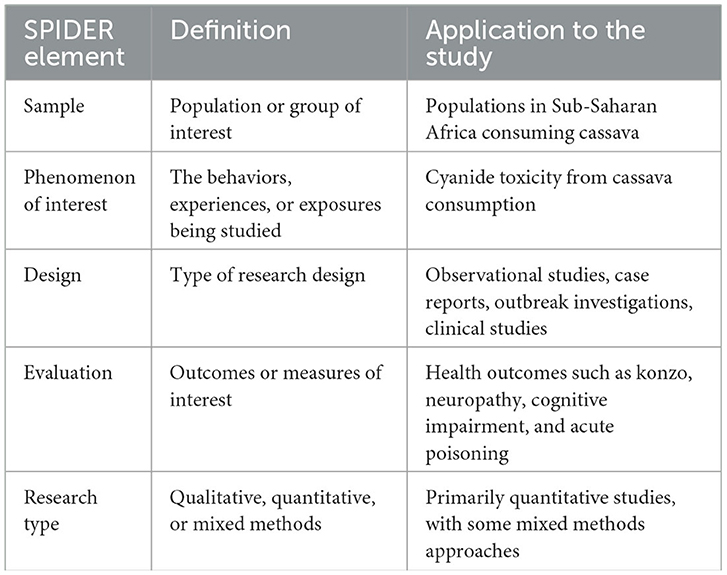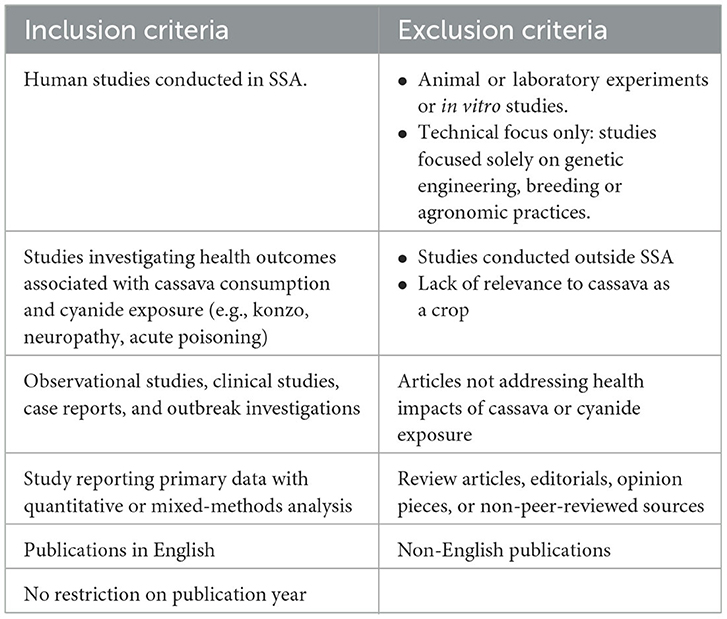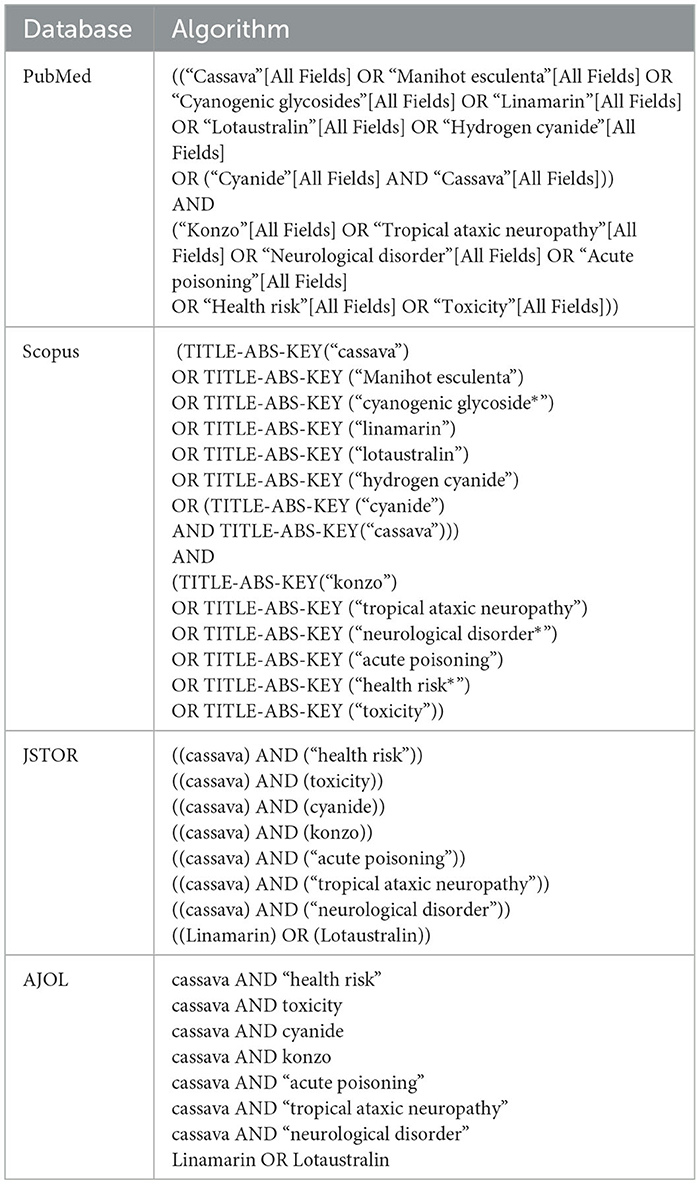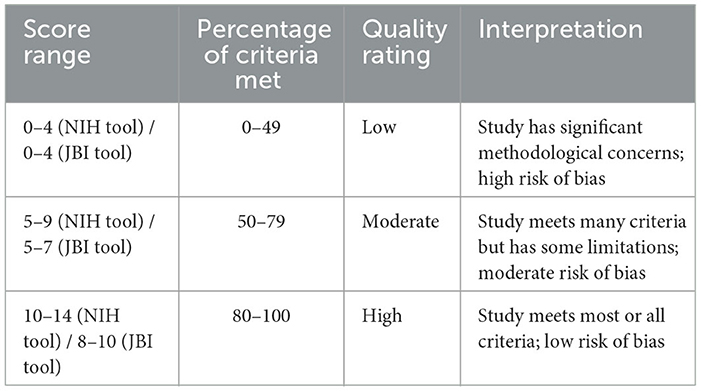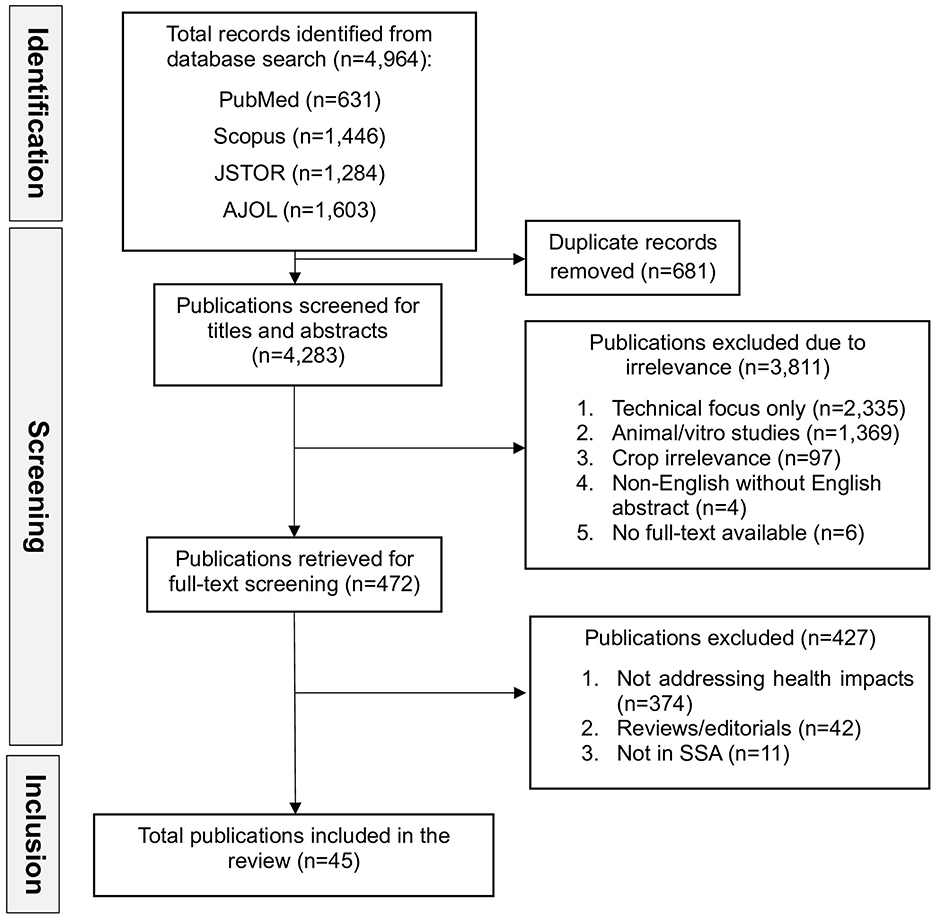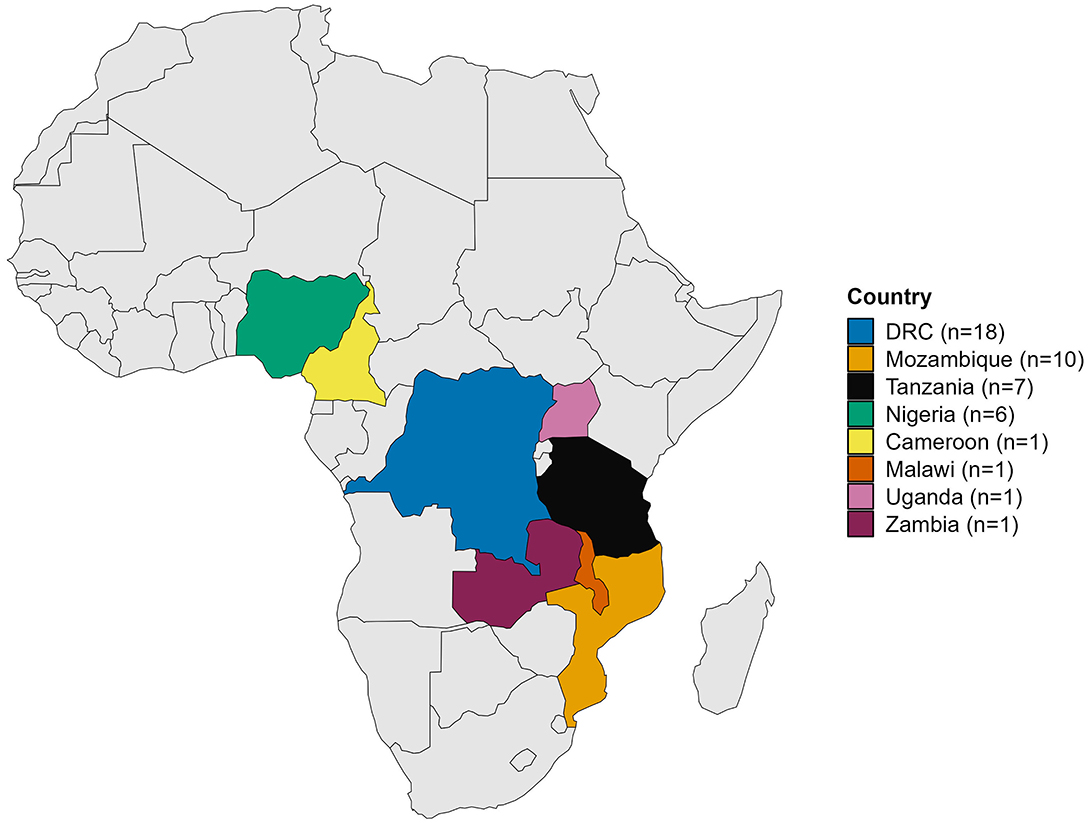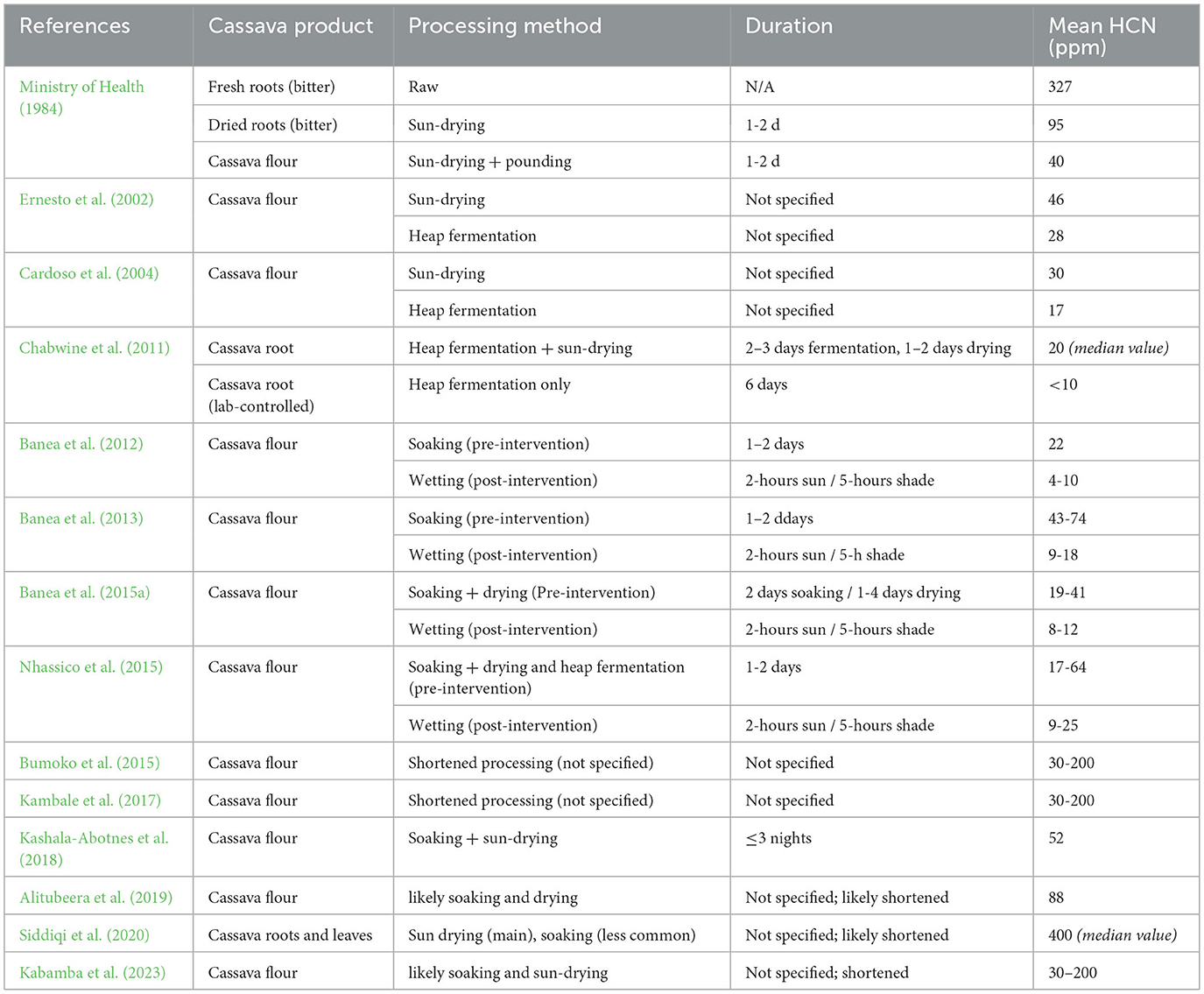- 1Department of Human Nutrition and Health, Bunda College, Lilongwe University of Agriculture and Natural Resources, Lilongwe, Malawi
- 2Department of Monitoring and Evaluation, Soils, Food and Healthy Communities (SFHC), Mzuzu, Malawi
- 3Department of Food Science and Technology, Bunda College, Lilongwe University of Agriculture and Natural Resources, Lilongwe, Malawi
Objective: Cassava (Manihot esculenta Crantz) remains a vital staple crop across Sub-Saharan Africa (SSA), sustaining millions of livelihoods. However, its consumption poses a significant public health concern due to the presence of cyanogenic glycosides. This systematic review synthesizes evidence on the health impacts of cyanide exposure from cassava consumption in SSA and examines how these risks are shaped by structural vulnerabilities in food systems.
Methods: A comprehensive literature search was conducted across four databases: PubMed, Scopus, JSTOR, and AJOL. Retrieved publications were organized using Mendeley Desktop. The review followed the Preferred Reporting Items for Systematic Reviews and Meta-Analyses (PRISMA) guidelines. Two independent reviewers carried out the search and screening processes, with any disagreements resolved through discussion with a third reviewer. The review included human epidemiological studies—observational, interventional, and clinical—that examined the health impacts of dietary cassava intake among populations in SSA. The keywords used in the search included cassava, cyanide, hydrogen cyanide, linamarin, lotaustralin, cyanogenic glycosides, konzo, health risk, acute poisoning, toxicity, tropical ataxic neuropathy, and neurological disorder. The initial search was conducted in January 2025 and updated on 24th June 2025.
Results: The review identified 45 relevant studies, with the majority conducted in the Democratic Republic of Congo (n = 18), followed by Mozambique (n = 10), Tanzania (n = 7), and Nigeria (n = 6). Urinary thiocyanate levels often exceeded the World Health Organization's safety threshold of 350 μmol/L, reaching up to 1,730 μmol/L, particularly among individuals affected by konzo. These adverse health outcomes were often compounded by armed conflict, drought, poor infrastructure, and protein-deficient diets. Climate-related stressors, such as El Niño events and prolonged dry spells may further intensify reliance on cassava, resulting in the consumption of inadequately processed roots. Residual Hydrogen Cyanide (HCN) concentrations in cassava products varied widely depending on the processing method. Among these, the wetting method consistently achieved the greatest reductions, lowering HCN levels to as little as 4 ppm.
Conclusion: Cyanide exposure from cassava remains a significant public health concern in SSA, particularly in areas with fragile food systems and limited access to safe processing methods. Strengthening food system resilience, expanding access to safer cassava cultivars (e.g., biofortified cassava varieties), and promoting effective processing methods such as wetting, are essential strategies for reducing cassava-related health risks.
1 Introduction
Cassava (Manihot esculenta Crantz) is the world's fourth most important staple food, following rice, wheat, and maize, and serves as a dietary staple for over one billion people worldwide (Adebayo, 2023). Its resistance to drought, ability to thrive even in poor soils, and flexibility to be planted and harvested nearly year-round, underscore its critical role in food security, particularly in drought-prone and nutrient-depleted regions like Sub-Saharan Africa (SSA). Cassava occupies a pivotal role in the agricultural landscape of Africa, where it is the second most crucial staple crop after maize, with the highest per capita consumption occurring in SSA (Hood et al., 2023). On average, individuals in SSA consume ~300 g of cassava daily, contributing up to 37% of the region's dietary energy intake (Bamigboye, 2023). However, beyond its contributions to food security, cassava presents complex trade-offs.
As a region, SSA grapples with complex challenges, including climate change, declining agricultural productivity, and increasing food insecurity. In this context, cassava has emerged as a resilient and indispensable crop that is promoted as a drought-tolerant crop [Food and Agriculture Organization of the United Nations (FAO), 2022] that sustains livelihoods across diverse landscapes. Recent trends, particularly between 2010 and 2023, show that cassava production in SSA is on the rise, driven by its growing significance as a food security crop amidst worsening climate variability, declining yields of traditional cereals like maize and rice, and increasing population pressures (FAOSTAT, 2025; Otekunrin, 2024).
Nutritionally, cassava is a source of starch, delivering 160 kcal/100 g when consumed raw, while its protein (<2%), fat (<1%), and micronutrient content (<1%) are minimal (Salvador et al., 2014). Due to its wide consumption as a staple food in SSA, where vitamin A deficiency remains a significant public health problem (UNICEF, 2023), biofortification programmes have successfully developed biofortified cassava varieties enriched with pro-vitamin A that have proven efficacy in improving serum retinol in school children (Talsma et al., 2016) and acceptable by consumers (Bechoff et al., 2018). As cassava broadens, it will likely continue to be promoted, increasing access and consumption in many SSA societies.
Despite the resilience and potential that cassava possesses, the utilization of cassava and its products is to some extent compromised by cyanide. Cyanogenic glycosides, primarily linamarin and lotaustralin which exist in the ratio 97:3 (Lykkesfeldt and Lindberg Møller, 1994) are natural constituents of cassava that present a real threat to human health (Rivadeneyra-Domínguez and Rodríguez-Landa, 2020). Cassava is considered bitter if its cyanide concentrations exceed 100 mg/kg, and sweet if cyanide levels are below 100 mg/kg (Fukushima et al., 2016). Consumption of inadequately processed bitter cassava results in enzymatic hydrolysis to release Hydrogen Cyanide (HCN), a potent toxin with deleterious effects on physiological functions. Cumulative exposure to cyanide has been linked to a range of adverse health outcomes, including acute poisoning and chronic neurological conditions such as tropical ataxic neuropathy and konzo—a paralytic neurological disease primarily linked to cyanide exposure and commonly affecting children and women of reproductive age (Siddiqi et al., 2020; Alitubeera et al., 2019; Oluwole and Oludiran, 2013).
Importantly, the choice to grow bitter cassava is not always accidental or a result of limited knowledge. In many SSA communities, farmers intentionally cultivate bitter varieties due to their higher yield potential, better storability, and suitability for processing into flour (Imakumbili et al., 2019; Oluwole et al., 2007). Moreover, environmental factors such as soil characteristics and crop management practices—including poor weeding, piecemeal harvesting, and the age of the plant at harvest—can influence cassava root bitterness and subsequently increase cyanogenic glucoside production (Imakumbili et al., 2019). Additionally, bitter cassava serves as a natural deterrent to pests, livestock, and theft, as its toxicity discourages unwanted harvesting or consumption before proper processing (Kapinga et al., 1997; Chiwona-Karltun et al., 1998). This suggests that cyanide exposure from cassava and cassava-related products is still prevalent in SSA (Forkum et al., 2025). This health risk is further compounded by the fragility of food systems in the region, encompassing production, processing, storage, distribution, and consumption. These components are often fragmented, under-resourced, and vulnerable to a range of stressors, including climate variability, land degradation, socio-economic inequality, and political instability (Ulimwengu, 2024; Bjornlund et al., 2022). Such systemic weaknesses hinder the adoption of safe cassava processing practices such as adequate fermentation, wetting, drying, or soaking needed to reduce cyanide levels in cassava. Hence, populations remain at risk of chronic or acute cyanide exposure. Despite such systemic challenges, reliance on cassava continues to grow.
While various reviews have examined cassava toxicity and efforts to mitigate cyanide toxicity through cassava processing methods (Kuliahsari et al., 2021; Panghal et al., 2021; McMahon et al., 1995), specific cyanide-related health conditions such as konzo (Baguma et al., 2021; Rivadeneyra-Domínguez and Rodríguez-Landa, 2020; Cliff et al., 2011; Kashala-Abotnes et al., 2019; Nhassico et al., 2008; Aregheore and Agunbiade, 1991), as well as the safety of cassava and cassava-derived products (Forkum et al., 2025), remain persistent public health concerns. However, there is a critical gap in understanding how these health risks are embedded within and perpetuated by the broader structural vulnerabilities of food systems in SSA. Therefore, the objective of this review was to synthesize existing evidence on the health risks associated with cyanide exposure from cassava consumption in SSA, and to examine how these risks are shaped and perpetuated by structural vulnerabilities within the region's food systems. The review aims to inform integrated, context-sensitive interventions that promote food safety, public health, and sustainable food systems.
2 Methods
This systematic review was conducted following guidelines outlined in the Preferred Reporting Items for Systematic Reviews and Meta-Analyses statement (PRISMA 2020) (Page et al., 2021). Given the nature of the research question and the diversity of study designs, the SPIDER framework (Sample, Phenomenon of Interest, Design, Evaluation, Research type) was employed to structure the review objectives and eligibility criteria, as it is particularly effective for synthesizing qualitative and mixed-methods research (Cooke et al., 2012). Table 1 shows the SPIDER framework and its application to this study.
2.1 Eligibility criteria
The inclusion and exclusion criteria were developed not only to ensure methodological rigor but also to align with the review's central theme: understanding the health risks of cassava consumption through the lens of unsustainable food systems in SSA. These criteria ensure that the selected studies reflect the human health consequences of systemic weaknesses in food systems within SSA. Table 2 shows the inclusion and exclusion criteria for the review.
2.2 Information sources and search strategy
A comprehensive literature search was conducted in the following electronic databases: PubMed, Scopus, Journal Storage (JSTOR), and African Journals Online (AJOL). Prior to the search, an academic librarian was consulted to assist in developing comprehensive search strategies, identifying relevant databases, optimizing keywords and subject heading selection, and ensuring rigorous adherence to the PRISMA guidelines. The search strategy used a combination of relevant keywords and concepts related to cassava and cyanide. The keywords used in the search included cassava, cyanide, hydrogen cyanide, linamarin, lotaustralin, cyanogenic glycosides, konzo, health risk, acute poisoning, toxicity, tropical ataxic neuropathy, and neurological disorder. A full search index and the Boolean search strings used for each database are shown in Table 3. To ensure comprehensive search, no restrictions or filters were placed on publication year, language or country during the search of various databases. The initial search was conducted in January 2025 and updated on 24th June 2025. Two independent reviewers performed the search and screening processes and resolved any disagreements through discussion or consultation with a third reviewer. Supplementary data illustrating cassava production trends were obtained from FAOSTAT (2025).
2.3 Study selection and data extraction
All database search results were collated, stored, and managed in Mendeley desktop software (version 1.19.8). Multiple folders were created in Mendeley to contain the results of each database search, and then all the results were aggregated into a single folder with duplicates removed. The study selection process was conducted in two phases: an initial screening of titles and abstracts, followed by a full-text review of potentially eligible studies. Data from the included studies were extracted using a standardized data extraction form. The extracted data included: study characteristics (i.e., authors, publication year, study location, study population); cyanide exposure assessment (i.e., thiocyanate concentrations); residual HCN concentrations and cassava processing methods; reported health outcomes or adverse effects; and potential confounding factors.
2.3.1 Risk of bias and quality assessment of included studies
A comprehensive quality appraisal was conducted for all studies included in this review, following the PRISMA 2020 guidelines. Study quality was assessed using the NIH Quality Assessment Tool for Observational Cohort and Cross-Sectional Studies [National Heart, Lung, and Blood Institute (NHLBI), 2013] and the JBI Critical Appraisal Checklist for Case Series [Joanna Briggs Institute (JBI), 2017], depending on study design. Each study was independently evaluated by two reviewers to minimize bias. Any discrepancies were resolved through discussion and consensus. Table 4 summaries the quality rating score.
2.4 Data synthesis and analysis
The findings from the included studies were synthesized based on geographical distribution (country of study population), cyanide exposure levels reported (e.g., in μmol L−1), reported health outcomes (e.g., konzo, tropical neuropathy, acute poisoning), and their underlying factors such as processing methods and HCN concentrations in cassava products. A geographic map and tabular summaries were used as appropriate to the data. The findings have been reported following the PRISMA statement, including a flow diagram of the study selection process, tabular summaries of study characteristics (design, population, and key findings), and narrative syntheses, highlighting patterns, contradictions and gaps, as appropriate.
3 Results
3.1 List of included publications
The initial database search identified a total of 4,964 records: PubMed (n = 631), Scopus (n = 1,446), JSTOR (n = 1,284), and AJOL (n = 1,603). After removing 681 duplicate records, 4,283 unique records were screened for titles and abstracts. From this pool, 472 publications were retrieved for full-text screening. Records were excluded at this stage based on irrelevance to the topic, that is, purely technical focus, use of animal or in vitro models, lack of relevance to cassava as a crop, non-English language, or unavailability of the full text. Following full-text screening, 426 publications were excluded for not addressing health impacts, being review articles or editorials, or being conducted outside SSA. Finally, 45 studies met the inclusion criteria and were included in the final review (Figure 1).
3.1.1 Quality appraisal of included studies
Out of the 45 studies, 24 were appraised using the JBI Critical Appraisal Checklist for Case Series tool and 21 using the NIH Quality Assessment Tool for Observational Cohort and Cross-Sectional Studies tool (Table 5). Most studies (n = 26, 58%) were rated as having moderate quality, while 19 studies (42%) were rated as high quality. No study was rated as low quality. Among the JBI-assessed studies, quality scores ranged from 67% to 90%, with most studies meeting 8 or 9 out of 10 criteria. For the NIH-assessed studies, scores ranged from 62% to 80%, with most studies meeting 8 or 9 out of 14 criteria. Common limitations included lack of clarity in participant selection, absence of blinding, and limited reporting on confounding factors.
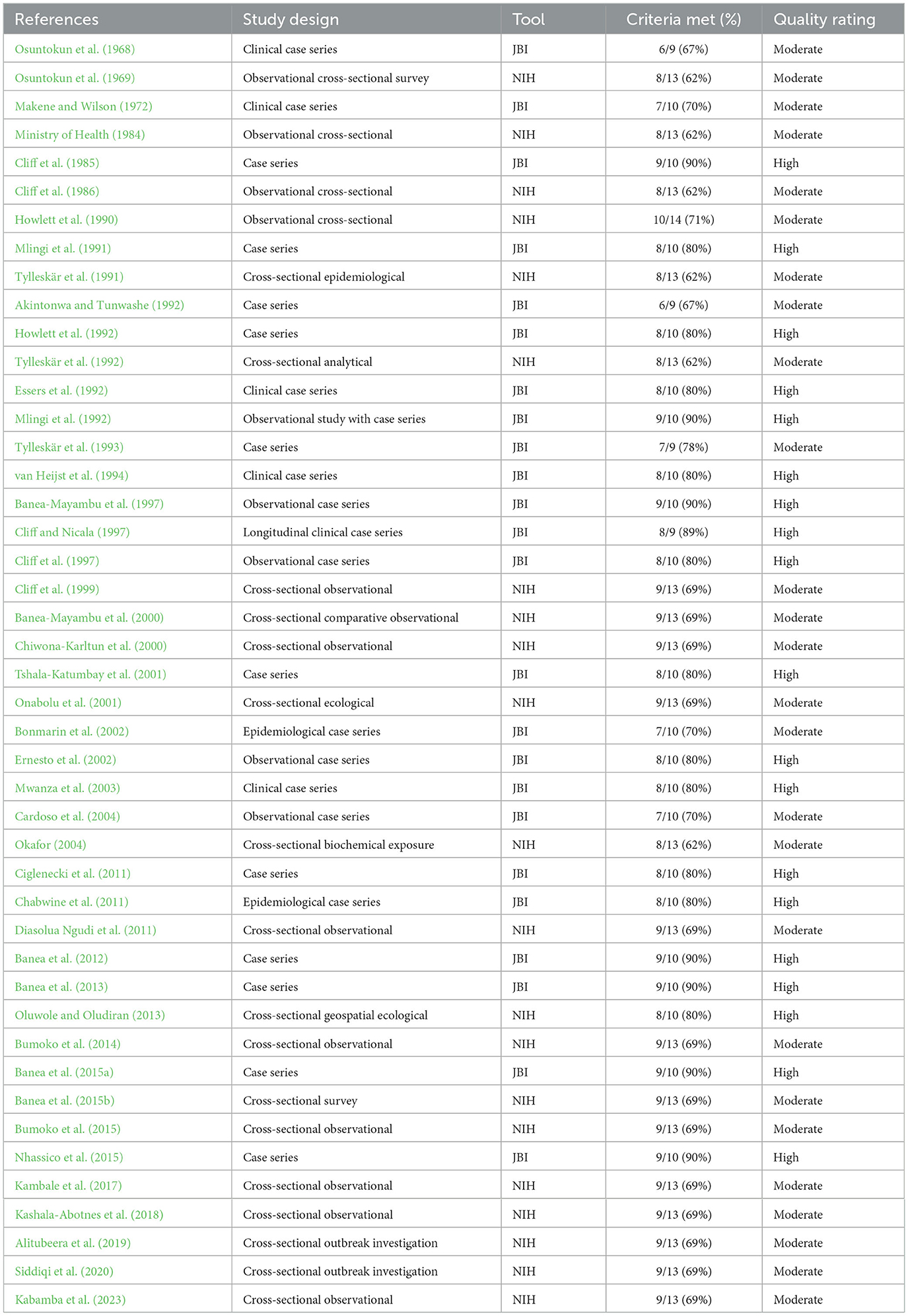
Table 5. Quality appraisal of all included studies using JBI Critical Appraisal Checklist for Case Series and NIH Quality Assessment Tool for Observational Cohort and Cross-Sectional Studies.
3.2 Geographical scope of included publications
Figure 2 illustrates the frequency of included publications by the country where the studies were conducted. The Democratic Republic of Congo (DRC) had the highest frequency of publications (n = 18), followed by Mozambique (n= 10), Tanzania (n =7), and Nigeria (n = 6). Other countries such as Malawi, Uganda, Zambia, and Cameroon each contributed only one study. This distribution highlights a concentration of research activity in regions with a high burden of cassava-related cyanide exposure, particularly in Central and East Africa.
3.2.1 Cassava production trends
Figure 3 illustrates increasing cassava production trends from 2000 to 2023 in selected countries. Notably, Nigeria and DRC demonstrated the most pronounced increases. Specifically, cassava production in DRC has shown a consistent and sustained rise since 2010. Although Nigeria experienced an overall substantial rise during the same period, production declined in 2013, 2019, and 2020.
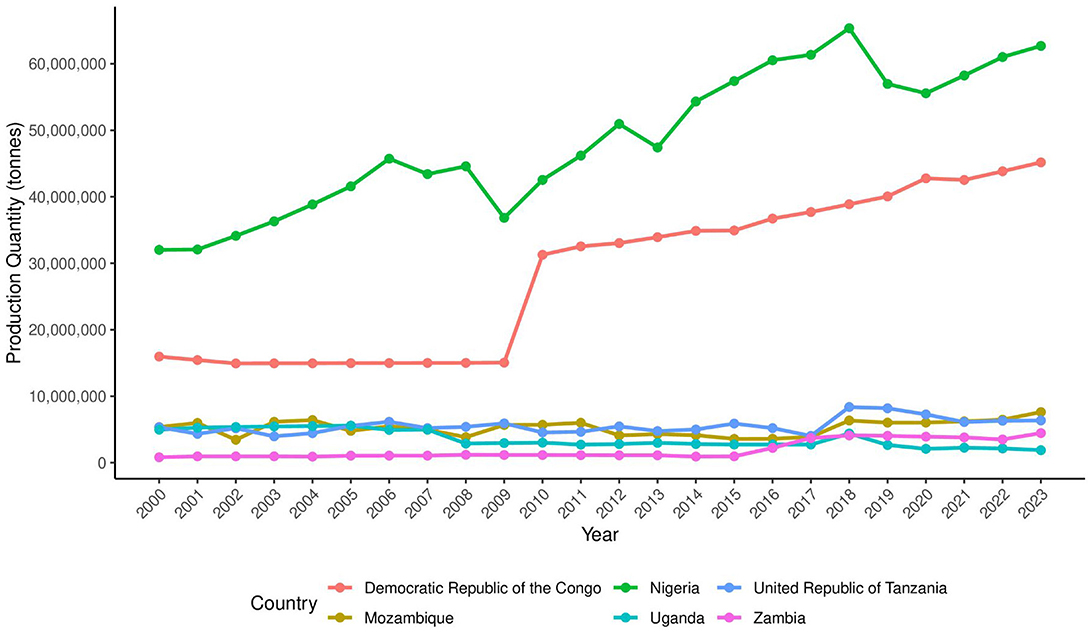
Figure 3. Cassava production trends in selected countries (2000-2023). Data Source: FAOSTAT (2025).
3.3 Urinary thiocyanate concentration and associated health conditions
Urinary thiocyanate levels, a biomarker of cyanide exposure from cassava consumption, were reported in 28 of the 45 included studies (Table 6). The levels varied widely across populations, health conditions, and intervention periods. Several studies, particularly those conducted in the DRC, Mozambique, and Tanzania, reported extremely high thiocyanate levels, far above the World Health Organization's safety threshold of 350 μmol/L for urinary thiocyanate. The highest concentrations were observed in individuals diagnosed with konzo - a neurological disorder linked to cyanide toxicity. For instance, (Tshala-Katumbay et al. 2001) reported concentrations of 1,128 μmol/L among individuals with konzo in the DRC, while (Mlingi et al. 1991) reported a mean value of 1,730 μmol/L at the onset of a konzo outbreak in Tanzania. Similarly, (Tylleskär et al. 1992) found levels of 757 μmol/L in affected children compared to 50 μmol/L in unaffected peers. In addition, neurological conditions (e.g., tropical ataxic neuropathy), cognitive impairment, and acute intoxication events were reported.
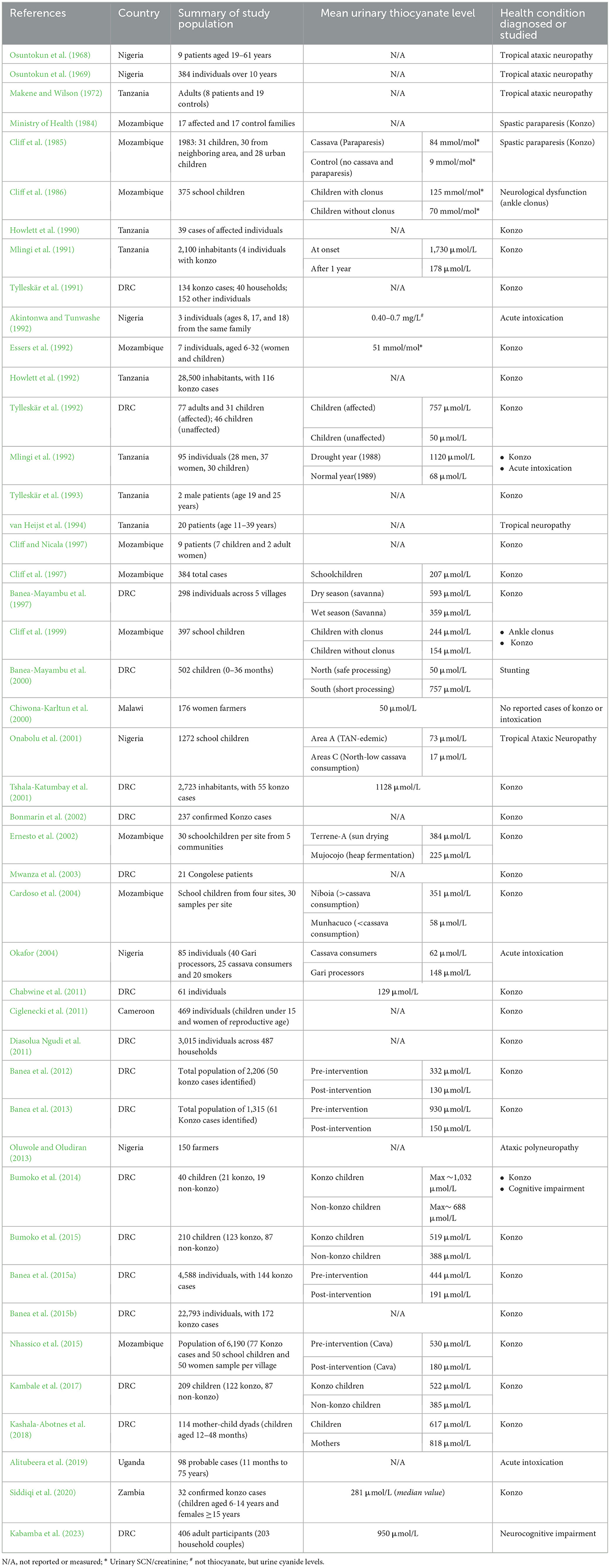
Table 6. Urinary thiocyanate concentrations and related health conditions reported in the included studies.
Several studies demonstrated the impact of interventions aimed at improving cassava processing. For example, (Banea et al. 2013) reported a reduction from 930 μmol/L pre-intervention to 150 μmol/L post-intervention. Comparable declines were observed in (Nhassico et al. 2015) (from 530 μmol/L to 180 μmol/L) and (Banea et al. 2015a) (from 444 μmol/L to 191 μmol/L). In contrast, populations with safer cassava processing practices or lower cassava consumption exhibited significantly lower thiocyanate levels. For instance, (Chiwona-Karltun et al. 2000) and (Onabolu et al. 2001) reported levels as low as 50 μmol/L and 17 μmol/L, respectively, in non-endemic or low-consumption areas (Table 6).
3.4 Cassava processing methods and residual hydrogen cyanide (HCN) concentrations
Table 7 shows substantial variability in residual Hydrogen Cyanide (HCN) concentrations across different cassava processing methods and duration. Raw bitter cassava roots contained the highest HCN levels, with concentrations reaching 327 ppm (Ministry of Health, 1984). In contrast, properly processed cassava flour showed significantly reduced HCN levels, depending on the method and duration of processing. Sun-drying alone reduced HCN levels to between 30 and 95 ppm, while heap fermentation was more effective, lowering concentrations to as low as 17–28 ppm (Cardoso et al., 2004; Ernesto et al., 2002). The combination of heap fermentation and sun-drying further reduced HCN to < 10–20 ppm, particularly under lab-controlled fermentation conditions for 6 d (Chabwine et al., 2011).
Studies involving wetting methods (i.e., 2 h sun and 5-h shade exposure) as a cassava processing intervention consistently achieved the lowest HCN levels. (eg.,) (Banea et al. 2012, 2013, 2015a) and (Nhassico et al. 2015) reported reductions from pre-intervention levels of 22–74 ppm to post-intervention levels of 4–25 ppm. In contrast, studies that documented unspecified or shortened processing methods consistently reported higher cyanide levels. (Bumoko et al. 2015); (Kambale et al. 2017); and (Kabamba et al. 2023) all recorded ranges between 30 and 200 ppm.
4 Discussion
4.1 Cassava's dual role in food security and cyanide-related health risks
This systematic review highlights the persistent public health risks associated with cyanide exposure from cassava consumption in SSA, despite the crop's critical role in regional food security. The findings reveal a complex interplay between agricultural practices, processing methods, and structural vulnerabilities within food systems that collectively shape the health outcomes of cassava consumers. In countries like the DRC and Mozambique, cassava was a critical staple, especially during periods of conflict, drought, or economic hardship. However, in these contexts, cassava plays a dual role: while it is a resilient and accessible food source, it also poses significant health risks due to its high cyanogenic glycoside content, particularly in bitter varieties. These risks were amplified when cassava was consumed without adequate processing, which remains common in many resource limited settings like SSA.
Despite the availability of effective processing methods such as wetting and heap fermentation, their adoption remains limited due to weaknesses and disruptions in SSA's food systems. For instance, wars and conflicts profoundly disrupt agricultural activities, food distribution, and household food security (Weldegiargis et al., 2023; Muriuki et al., 2023), forcing communities to rely heavily on inadequately processed cassava (Cliff et al., 1997). Socio-economic stress often forces households to rely on shortened or informal processing methods, which are less effective at detoxifying cassava. Moreover, the intentional cultivation of bitter varieties due to their pest resistance, storability, and yield further complicates efforts to reduce cyanide exposure (Imakumbili et al., 2019; Chiwona-Karltun et al., 1998; Kapinga et al., 1997). These food system challenges have intensified in recent years across SSA, exacerbated by climate change impacts such as prolonged dry spells, El Niño events, and cyclones (World Food Programme, 2024; United Nations Office for the Coordination of Humanitarian Affairs, 2022), all of which further entrench the over-reliance on cassava as a food security crop.
4.2 Geographical distribution of cyanide-related health risks
The burden of cassava-related health risks was concentrated in a few countries, most notably the DRC, Mozambique, Tanzania, and Nigeria. However, the absence of epidemiological data from other high cassava-consuming countries, such as Ghana and Malawi (Adebayo, 2023), may not necessarily indicate a lack of risk. In some cases, this may reflect weak surveillance systems to detect sub-lethal cyanide exposure or milder neurological symptoms that are not present as overt clinical cases. Nonetheless, it may also reflect the absence of key contributing factors such as wars and conflicts or the widespread use of safer processing practices, as observed in Malawi (Chiwona-Karltun et al., 2000). Furthermore, many of the studies included in this review are decades old, suggesting either a decline in research interest—possibly due to reduced funding—or a genuine reduction in incidence, potentially linked to increased awareness and improved cassava processing practices. This gap highlights the urgent need for renewed investment in research and the strengthening of surveillance systems to capture both acute and chronic health effects of cyanide exposure in cassava-consuming populations.
4.3 Health risks associated with cyanide exposure
The review revealed a consistent association between cassava consumption and neurological conditions such as konzo and tropical ataxic neuropathy (TAN). Konzo is characterized by a sudden onset of non-progressive spastic paraparesis, leading to severe motor impairment and often resulting in irreversible disability (Kashala-Abotnes et al., 2019; World Health Organization, 1996; Tylleskär et al., 1991). In contrast, TAN presents as a progressive condition involving both sensory and motor deficits, while broader neuropathies may arise from prolonged, low-level cyanide exposure (Adamolekun, 2011).
Biomarker data, particularly urinary thiocyanate levels, provided strong evidence of chronic cyanide exposure in affected populations (Cliff et al., 2011). In several studies (Bumoko et al., 2014, 2015; Tshala-Katumbay et al., 2001; Mlingi et al., 1992), levels exceeded WHO recommended safety limit of 350 μmol/L (World Health Organization, 1996). In contrast, lower thiocyanate levels (< 350 μmol/L) were typically observed in populations with access to adequately processed cassava, reduced reliance on cassava as a staple, or the use of low-cyanide cassava varieties. These findings highlight the effectiveness of targeted mitigation strategies in reducing cyanide exposure and preventing associated health outcomes.
4.4 Effectiveness of cassava processing methods and recent advances
Processing methods play a critical role in determining the residual HCN levels in cassava products. Raw bitter cassava roots were found to contain extremely high HCN concentrations, reaching up to 327 ppm (Ministry of Health, 1984). In contrast, more effective processing techniques, particularly heap fermentation and the wetting method consistently reduced HCN levels to below the WHO's recommended safety limit of 10 ppm for cassava flour and dried cassava products (FAO/WHO, 2011). Post-intervention studies, particularly using the wetting method, demonstrated substantial reductions in HCN content, with some achieving levels as low as 4–10 ppm (Banea et al., 2012, 2013). However, the review also found that shortened or improperly applied methods, such as soaking for only 1–2 days, often resulted in dangerously high HCN levels—sometimes exceeding 400 ppm. These inadequate practices were frequently driven by time constraints, limited awareness, or lack of access to water. Such findings underscore the urgent need to promote improved cassava processing techniques, particularly the wetting method, and to strengthen community education on safe detoxification practices to reduce the risk of cyanide exposure.
In addition to traditional or conventional processing methods, recent innovations in cassava breeding and processing technologies offer promising solutions. Notably, bio fortified cassava varieties such as UMUCASS-38 (TMS 01/1371) and NR-8082, developed through collaborative efforts involving the [International Institute of Tropical Agriculture (IITA), 2012] and Harvest Plus, combine high yield, drought tolerance, and enhanced pro vitamin A content with low cyanogenic potential (Odoemelam et al., 2020). These varieties have been shown to contain cyanide levels of approximately 17.02 ± 0.02 ppm (UMUCASS-38) and 18.01 ± 0.01 ppm (NR-8082) in flour form, which are well below the WHO's safety threshold of 50 ppm for fresh cassava roots (FAO/WHO, 2011). Technologies such as hydraulic pressing, mechanical peeling, and grated fermentation have also been developed to enhance detoxification and reduce processing time [International Institute of Tropical Agriculture (IITA), 2012]. However, adoption of these innovations remains limited in many rural areas due to affordability constraints, weak extension services, and low awareness (Nweke et al., 2002). Cultural food preferences and the time-intensive nature of some improved methods may also hinder uptake. Expanding access to improved varieties, strengthening extension systems, and promoting behavior change communication are essential for scaling up safe cassava utilization.
4.5 Protein deficiency and nutritional vulnerability
Protein-deficient diets are a major underlying contributor to cyanide-related health risks. Many populations consuming bitter cassava lacked access to protein-rich foods that provide sulfur-containing amino acids, such as methionine and cysteine, critical for detoxifying cyanide into thiocyanate (Richie et al., 2023). Without sufficient intake of quality protein, the risk of conditions like konzo increased significantly (Tylleskär et al., 1995; Cliff et al., 1985; Ministry of Health, 1984). For instance, the [Integrated Food Security Phase Classification (IPC), 2022a] estimated that approximately 26.4 million people in the DRC experienced high levels of acute food insecurity (IPC Phase 3 or above) between July and December 2022, driven by widespread poverty, conflict, displacement, low agricultural production, high food prices, and poor infrastructure [Integrated Food Security Phase Classification (IPC), 2022b]. For instance, in Malawi – a country where cassava is consumed – protein poverty is evident, as most dietary protein comes from cereals that are low in essential amino acids like lysine and tryptophan [International Food Policy Research Institute (IFPRI), 2020a,b; Muleya et al., 2022]. In addition, poor dietary diversity further contributes to deficiencies in micronutrients like selenium, calcium, and zinc, which are essential for neurological health and resilience to cyanide toxicity (Kurmi et al., 2023).
4.6 Cassava dependency and its implications for the broader food systems
This review also underscores how cassava toxicity reveals broader systemic vulnerabilities within SSA's food systems. In the context of worsening climate change, persistent conflict, economic fragility, and weak infrastructure, cassava remains one of the few accessible, drought-resilient crops, even when its consumption carries serious health risks. During the 2022/23 period, over 55 million people in 12 countries within the [Southern African Development Community (SADC), 2022] were food insecure. Additionally, 35 non-international armed conflicts were active across Africa in 2024 (Geneva Academy of International Humanitarian Law, and Human Rights, 2025). These persistent challenges reduce the viability of other staples, disrupt markets and agricultural production, and limit access to safe, nutritious diets. These pressures are unlikely to subside in the near future, reinforcing the chronic nature of cyanide toxicity. Strengthening food systems through continuous surveillance, support for diversified and climate-resilient agriculture, and the promotion of food sovereignty where communities control their food production and processing is essential for long term mitigation.
4.7 Strengths and limitations of the study
This review has several strengths that enhance the credibility and comprehensiveness of its findings. First, it employed a broad search strategy across multiple databases—PubMed, Scopus, JSTOR, and AJOL, ensuring the inclusion of country and region-specific studies. Second, the methodological quality of all included studies was rigorously assessed using validated tools: JBI Critical Appraisal Checklist for Case Series and NIH Quality Assessment Tool for Observational Cohort and Cross-Sectional Studies. Third, the review adhered to the PRISMA guidelines, promoting transparency, reproducibility, and methodological rigor. Finally, the involvement of multiple reviewers in both the screening and risk of bias assessment processes helped enhance consistency and reduce the risk of selection bias. Despite these strengths, the review has a limitation. The exclusion of non-English language publications may have introduced language bias. However, to minimize this effect, studies with English titles and abstracts were screened for relevance, even if the full text was not available in English. While this approach helped reduce the risk of overlooking important studies, it may still have led to the omission of valuable data published in other languages.
5 Conclusion
This systematic review has underscored the ongoing public health threat posed by cassava cyanide toxicity in SSA, particularly in countries like the DRC and Mozambique, where the combined effects of conflict, drought, protein-deficient diets, and unsustainable food systems continue to undermine food and nutrition security. These challenges have intensified in recent years across SSA exacerbated by climate change phenomena such as prolonged dry spells, El Niño, and cyclones, along with global economic and political instability. Together, these factors reinforce reliance on cassava as a staple crop, increasing the risk of cyanide exposure, especially in communities lacking access to improved processing methods or safer cassava varieties.
While notable progress has been made through the development of low-cyanide cassava varieties (e.g., bio fortified cassava varieties) and improved processing innovations (e.g., wetting method), adoption remains uneven due to limited awareness, time constraints, inadequate extension support, cultural preferences, and water scarcity. Scaling up education on effective detoxification techniques such as wetting and heap fermentation and ensuring the availability and affordability of low-HCN cassava varieties are critical steps forward. Achieving this requires not only technical solutions but also broader support for food system transformation through research investment and community-led approaches that prioritize food sovereignty.
Data availability statement
The original contributions presented in the study are included in the article, further inquiries can be directed to the corresponding author.
Author contributions
GO: Writing – review & editing, Conceptualization, Writing – original draft, Investigation, Formal analysis, Data curation, Methodology, Visualization. WM: Investigation, Writing – review & editing, Conceptualization, Writing – original draft, Visualization, Methodology, Data curation, Formal analysis. KM: Conceptualization, Writing – review & editing, Formal analysis, Methodology. TN-M: Conceptualization, Supervision, Methodology, Writing – review & editing. AK: Visualization, Supervision, Writing – review & editing, Methodology, Conceptualization.
Funding
The author(s) declare that no financial support was received for the research and/or publication of this article.
Acknowledgments
The authors would like to thank the Lilongwe University of Agriculture and Natural Resources (LUANAR), where the review has been conducted, and the librarian, Antony Nyangulu, at the university for guidance on literature search.
Conflict of interest
The authors declare that the research was conducted in the absence of any commercial or financial relationships that could be construed as a potential conflict of interest.
Generative AI statement
The author(s) declare that no Gen AI was used in the creation of this manuscript.
Any alternative text (alt text) provided alongside figures in this article has been generated by Frontiers with the support of artificial intelligence and reasonable efforts have been made to ensure accuracy, including review by the authors wherever possible. If you identify any issues, please contact us.
Publisher's note
All claims expressed in this article are solely those of the authors and do not necessarily represent those of their affiliated organizations, or those of the publisher, the editors and the reviewers. Any product that may be evaluated in this article, or claim that may be made by its manufacturer, is not guaranteed or endorsed by the publisher.
References
Adamolekun, B. (2011). Neurological disorders associated with cassava diet: a review of putative etiological mechanisms. Metab. Brain Dis. 26, 79–85 doi: 10.1007/s11011-011-9237-y
Adebayo, W. G. (2023). Cassava production in Africa: a panel analysis of the drivers and trends. Heliyon 9:e19939. doi: 10.1016/j.heliyon.2023.e19939
Akintonwa, A., and Tunwashe, O. L. (1992). Fatal cyanide poisoning from cassava-based Meal. Hum. Exp. Toxicol. 11, 47–49. doi: 10.1177/096032719201100107
Alitubeera, P. H., Eyu, P., Kwesiga, B., Ario, A. R., and Zhu, B.-P. (2019). Outbreak of cyanide poisoning caused by consumption of cassava flour - Kasese District, Uganda, September 2017. MMWR 68, 308–311. doi: 10.15585/mmwr.mm6813a3
Aregheore, E. M., and Agunbiade, O. O. (1991). The toxic effects of cassava (Manihot esculenta Grantz) diets on humans: a review. Vet. Hum. Toxicol. 33, 274–275.
Baguma, M., Nzabara, F., Maheshe Balemba, G., Malembaka, E. B., Migabo, C., Mudumbi, G., et al. (2021). Konzo risk factors, determinants and etiopathogenesis: what is new? A systematic review. Neurotoxicology 85, 54–67. doi: 10.1016/j.neuro.2021.05.001
Bamigboye, T. (2023). Cassava: The Power Crop for Africa?s Food Future. Foodlog. Available online at: https://agrifoodnetworks.org/article/cassava-the-power-crop-for-africas-food-future (Accessed March 4, 2025).
Banea, J. P., Bradbury, J. H., Mandombi, C., Nahimana, D., Denton, I. C., Foster, M. P., and Kuwa, N. (2015a). Konzo prevention in six villages in the DRC and the dependence of konzo prevalence on cyanide intake and malnutrition. Toxicol. Rep. 2, 609–616. doi: 10.1016/j.toxrep.2015.03.014
Banea, J. P., Bradbury, J. H., Mandombi, C., Nahimana, D., Denton, I. C., Kuwa, N., and Tshala Katumbay, D. (2013). Control of konzo by detoxification of cassava flour in three villages in the Democratic Republic of Congo. Food Chem. Toxicol. 60, 506–513. doi: 10.1016/j.fct.2013.08.012
Banea, J. P., Bradbury, J. H., Nahimana, D., Denton, I. C., Mashukano, N., and Kuwa, N. (2015b). Survey of the konzo prevalence of village people and their nutrition in Kwilu District, Bandundu Province, DRC. Afr. J. Food Sci. 92, 43–50. doi: 10.5897/AJFS2014.1206
Banea, J. P., Nahimana, G., Mandombi, C., Bradbury, J. H., Denton, I. C., and Kuwa, N. (2012). Control of konzo in DRC using the wetting method on cassava flour. Food Chem. Toxicol. 50, 1334–1337. doi: 10.1016/j.fct.2012.02.001
Banea-Mayambu, J. P., Tylleskär, T., Gitebo, N., Matadi, N., Gebre-Medhin, M., and Rosling, H. (1997). Geographical and seasonal association between linamarin and cyanide exposure from cassava and the upper motor neurone disease konzo in former Zaire. Trop. Med. Int. Health 2, 1143–1151. doi: 10.1046/j.1365-3156.1997.d01-215.x
Banea-Mayambu, J. P., Tylleskär, T., Tylleskär, K., Gebre-Medhin, M., and Rosling, H. (2000). Dietary cyanide from insufficiently processed cassava and growth retardation in children in the Democratic Republic of Congo (formerly Zaire). Ann. Trop. Paediatr. 20, 34–40. doi: 10.1080/02724930092048
Bechoff, A., Chijioke, U., Westby, A., and Tomlins, K. I. (2018). ‘Yellow is good for you': consumer perception and acceptability of fortified and biofortified cassava products. PLoS ONE 13:e0203421. doi: 10.1371/journal.pone.0203421
Bjornlund, V., Bjornlund, H., and van Rooyen, A. (2022). Why food insecurity persists in sub-Saharan Africa: a review of existing evidence. Food Secur. 14, 845–864. doi: 10.1007/s12571-022-01256-1
Bonmarin, I., Nunga, M., and Perea, W. A. (2002). Konzo outbreak, in the South-west of the Democratic Republic of Congo, 1996. J. Trop. Pediatr. 48, 234–238. doi: 10.1093/tropej/48.4.234
Bumoko, G. M., Sombo, M. T., Okitundu, L. D., Mumba, D. N., Kazadi, K. T., Tamfum-Muyembe, J. J., et al. (2014). Determinants of cognitive performance in children relying on cyanogenic cassava as staple food. Metab. Brain Dis. 29, 359–366. doi: 10.1007/s11011-014-9492-9
Bumoko, G. M. M., Sadiki, N. H., Rwatambuga, A., Kayembe, K. P., Okitundu, D. L., Mumba Ngoyi, D., et al. (2015). Lower serum levels of selenium, copper, and zinc are related to neuromotor impairments in children with konzo. J. Neurol. Sci. 349, 149–153. doi: 10.1016/j.jns.2015.01.007
Cardoso, A. P., Ernesto, M., Nicala, D., Mirione, E., Chavane, L., N'zwalo, H., et al. (2004). Combination of cassava flour cyanide and urinary thiocyanate measurements of school children in Mozambique. Int. J. Food Sci. Nutr. 55, 183–190. doi: 10.1080/09637480410001725265
Chabwine, J. N., Masheka, C., Balol'ebwami, Z., Maheshe, B., Balegamire, S., Rutega, B., et al. (2011). Appearance of konzo in South-Kivu, a wartorn area in the Democratic Republic of Congo. Food Chem. Toxicol. 49, 644–649. doi: 10.1016/j.fct.2010.07.050
Chiwona-Karltun, L., Mkumbira, J., Saka, J., Bovin, M., Mahungu, N. M., and Rosling, H. (1998). The importance of being bitter-a qualitative study on cassava cultivar preference in Malawi. Ecol. Food Nutr. 37, 219–245. doi: 10.1080/03670244.1998.9991546
Chiwona-Karltun, L., Tylleskar, T., Mkumbira, J., Gebre-Medhin, M., and Rosling, H. (2000). Low dietary cyanogen exposure from frequent consumption of potentially toxic cassava in Malawi. Int. J. Food Sci. Nutr. 51, 33–43. doi: 10.1080/096374800100886
Ciglenecki, I., Eyema, R., Kabanda, C., Taafo, F., Mekaoui, H., and Gaffga, N. (2011). Konzo outbreak among refugees from Central African Republic in Eastern region, Cameroon. Food Chem. Toxicol. 49, 579–582. doi: 10.1016/j.fct.2010.05.081
Cliff, J., Essers, S., and Rosling, H. (1986). Ankle clonus correlating with cyanide intake from cassava in rural children from Mozambique. J. Trop. Pediatr. 32, 186–189. doi: 10.1093/tropej/32.4.186
Cliff, J., Mårtensson, J., Lundqvist, P., Rosling, H., and Sörbo, B. (1985). Association of high cyanide and low sulphur intake in cassava-induced spastic paraparesis. Lancet 326, 1211–1215. doi: 10.1016/S0140-6736(85)90742-1
Cliff, J., Muquingue, H., Nhassico, D., Nzwalo, H., and Bradbury, J. H. (2011). Konzo and continuing cyanide intoxication from cassava in Mozambique. Food Chem. Toxicol. 49, 631–635. doi: 10.1016/j.fct.2010.06.056
Cliff, J., and Nicala, D. (1997). Long term follow-up of konzo patients. Trans. R. Soc. Trop. Med. Hyg. 91, 447–449. doi: 10.1016/S0035-9203(97)90279-0
Cliff, J., Nicala, D., Saute, F., Givragy, R., Azambuja, G., Taela, A., et al. (1997). Konzo associated with war in Mozambique. Trop. Med. Int. Health 2, 1068–1074. doi: 10.1046/j.1365-3156.1997.d01-178.x
Cliff, J., Nicala, D., Saute, F., Givragy, R., Azambuja, G., Taela, A., et al. (1999). Ankle clonus and thiocyanate, linamarin, and inorganic sulphate excretion in school children in communities with konzo, Mozambique. J. Trop. Pediatr. 45, 139–142. doi: 10.1093/tropej/45.3.139
Cooke, A., Smith, D., and Booth, A. (2012). Beyond PICO: The SPIDER tool for qualitative evidence synthesis. Qual. Health Res. 22, 1435–1443. doi: 10.1177/1049732312452938
Diasolua Ngudi, D., Banea-Mayambu, J.-P., Lambein, F., and Kolsteren, P. (2011). Konzo and dietary pattern in cassava-consuming populations of Popokabaka, Democratic Republic of Congo. Food Chem. Toxicol. 49, 613–619. doi: 10.1016/j.fct.2010.06.053
Ernesto, M., Cardoso, A. P., Nicala, D., Mirione, E., Massaza, F., Cliff, J., et al. (2002). Persistent konzo and cyanogen toxicity from cassava in northern Mozambique. Acta Trop. 82, 357–362. doi: 10.1016/S0001-706X(02)00042-6
Essers, A. J. A., Alsen, P., and Rosling, H. (1992). Insufficient processing of cassava induced acute intoxications and the paralytic disease konzo in a rural area of Mozambique. Ecol. Food Nutr. 28, 61–67. doi: 10.1080/03670244.1992.9991222
FAO/WHO (2011). Evaluation of Certain Food Additives and Contaminants: Seventy-Fourth Report of the Joint FAO/WHO Expert Committee on Food Additives (JECFA). WHO Technical Report Series No. 966. Geneva: World Health Organization. Available online at: https://apps.who.int/food-additives-contaminants-jecfa-database/Home/Chemical/1086 (Accessed July 2, 2025).
FAOSTAT (2025). Cassava production trends (2000–2023). Food and Agriculture Organization of the United Nations. Available online at: https://www.fao.org/faostat (Accessed May 16, 2025).
Food and Agriculture Organization of the United Nations (FAO) (2022). Exploring Cassava Futures: Building Cassava Climate Resilient Pathways In Lao PDR. FAO. Available online at: https://openknowledge.fao.org/server/api/core/bitstreams/98589197-5042-4321-b699-430c504f3091/content (Accessed November 7, 2024).
Forkum, A. T., Wung, A. E., Kelese, M. T., Ndum, C. M., Lontum, A., Kamga, E. B., et al. (2025). Safety of cassava and cassava-based products: a systematic review. Front. Sust. Food Syst. 9:1497609. doi: 10.3389/fsufs.2025.1497609
Fukushima, A. R., Nicoletti, M. A., Rodrigues, A. J., Pressutti, C., Almeida, J., Brandão, T., et al. (2016). Cassava flour: quantification of cyanide content. Food Nutr. Sci. 7, 592–599. doi: 10.4236/fns.2016.77060
Geneva Academy of International Humanitarian Law and Human Rights. (2025). Today's Armed Conflicts – Rule of Law in Armed Conflict (RULAC) Portal. Geneva: Geneva Academy. Available online at: https://www.geneva-academy.ch/galleries/today-s-armed-conflicts [Accessed Jul. 9, 2025].
Hood, A. S. C., Shackelford, G. E., Christie, A. P., Usieta, H. O., Martin, P. A., Sutherland, W. J., et al. (2023). A systematic map of cassava farming practices and their agricultural and environmental impacts using new ontologies: agri-ontologies 1.0. Ecol. Solut. Evid. 4:e12249. doi: 10.1002/2688-8319.12249
Howlett, W. P., Brubaker, G., Mlingi, N., and Rosling, H. (1992). A geographical cluster of konzo in Tanzania. J. Trop. Geogr. Neurol. 2, 102–108.
Howlett, W. P., Brubaker, G. R., Mlingi, N., and Rosling, H. (1990). Konzo, an epidemic upper motor neuron disease studied in Tanzania. Brain 113, 223–235. doi: 10.1093/brain/113.1.223
Imakumbili, M. L. E., Semu, E., Semoka, J. M. R., Abass, A., and Mkamilo, G. (2019). ‘Farmers' perceptions on the causes of cassava root bitterness: a case of konzo-affected Mtwara region, Tanzania', PLoS ONE 14:e0215527. doi: 10.1371/journal.pone.0215527
Integrated Food Security Phase Classification (IPC) (2022a). Democratic Republic of the Congo: Over 26 Million People Experiencing High Levels of Acute Food Insecurity, 70. Available online at: https://www.ipcinfo.org/ipcinfo-website/alerts-archive/issue-70/en/ (Accessed July 8, 2025).
Integrated Food Security Phase Classification (IPC) (2022b). Democratic Republic of the Congo: Acute Food Insecurity Situation July - December 2022 and Projection for January - June 2023. Rome: IPC Global Partners. Available online at: https://www.ipcinfo.org/ipc-country-analysis/details-map/en/c/1155972/?iso3=COD (Accessed July 8, 2025).
International Food Policy Research Institute (IFPRI) (2020a). Nutrient Consumption and Dietary Patterns in Malawi. Available online at: https://ebrary.ifpri.org/digital/api/collection/p15738coll2/id/133599/download (Accessed July 5, 2025).
International Food Policy Research Institute (IFPRI) (2020b). Malawi Strategy Support Program: Supporting Evidence-Based Policy Planning for Food Security and Nutrition. Washington, DC: IFPRI. Available online at: https://www.ifpri.org/program/malawi-strategy-support-program (Accessed July 4, 2025).
International Institute of Tropical Agriculture (IITA) (2012). Cassava Processing and Utilization. IITA Research Guide Series. Ibadan: IITA.
Joanna Briggs Institute (JBI) (2017). JBI Critical Appraisal Checklist for Case Series. The University of Adelaide. Available online at: https://jbi.global/critical-appraisal-tools
Kabamba, V. H., Luwa, D. O., Banea, J. P. M., Giordani, B., Boivin, M. J., Mumba-Ngoyi, D., et al. (2023). Screening for neurocognitive deficits in adult populations reliant on toxic cassava as the main source of food. Ann. Afr. Méd. 16, e5028–e5038. doi: 10.4314/aamed.v16i2.2
Kambale, K. J., Ali, E. R., Sadiki, N. H., Kayembe, K. P., Mvumbi, L. G., Yandju, D. L., et al. (2017). Lower sulfurtransferase detoxification rates of cyanide in konzo-a tropical spastic paralysis linked to cassava cyanogenic poisoning. Neurotoxicology 59, 256–262. doi: 10.1016/j.neuro.2016.05.016
Kapinga, R., Mlingi, N., and Rosling, H. (1997). Reasons for use of bitter cassava in Southern Tanzania. Afr. J. Trop. Root Crops 2, 81–84.
Kashala-Abotnes, E., Okitundu, D., Mumba, D., Boivin, M. J., Tylleskär, T., and Tshala-Katumbay, D. (2019). Konzo: a distinct neurological disease associated with food (cassava) cyanogenic poisoning. Brain Res. Bull. 145, 87–91. doi: 10.1016/j.brainresbull.2018.07.001
Kashala-Abotnes, E., Sombo, M. T., Okitundu, D. L., Kunyu, M., Makila-Mabe, G. B., Tylleskär, T., et al. (2018). Dietary cyanogen exposure and early child neurodevelopment: an observational study from the Democratic Republic of Congo. PLoS ONE 13:e0193261. doi: 10.1371/journal.pone.0193261
Kuliahsari, D. E., Sari, I. N. I., and Estiasih, T. (2021). Cyanide detoxification methods in food: a review. IOP Conf. Ser. Earth Environ. Sci. 733:012099. doi: 10.1088/1755-1315/733/1/012099
Kurmi, A., Jayswal, D. K., Saikia, D., and Lal, N. (2023). “Current perspective on malnutrition and human health,” in Nano-Biofortification for Human and Environmental Health, eds. V. D. Rajput and S. K. Verma (New York, NY: Springer), 155–177. doi: 10.1007/978-3-031-35147-1_9
Lykkesfeldt, J., and Lindberg Møller, B. (1994). Cyanogenic glycosides in cassava, Manihot esculenta Crantz. Acta Chem. Scand. 48, 178–180. doi: 10.3891/acta.chem.scand.48-0178
Makene, W. J., and Wilson, J. (1972). Biochemical studies in Tanzanian patients with ataxic tropical neuropathy. J. Neurol. Neurosurg. Psychiatry 35, 31–33. doi: 10.1136/jnnp.35.1.31
McMahon, J. M., White, W. L. B., and Sayre, R. T. (1995). Review article: cyanogenesis in cassava (Manihot esculenta Crantz). J. Exp. Bot. 46, 731–741. doi: 10.1093/jxb/46.7.731
Ministry of Health (1984). Mantakassa: an epidemic of spastic paraparesis associated with chronic cyanide intoxication in a cassava staple area of Mozambique. II. Nutritional factors and hydrocyanic acid content of cassava products. Bull. World Health Organ. 62, 485–492.
Mlingi, N., Kimatta, S., and Rosling, H. (1991). Konzo, a paralytic disease observed in southern Tanzania. Trop. Doct. 21, 24–25. doi: 10.1177/004947559102100110
Mlingi, N., Poulter, N. H., and Rosling, H. (1992). An outbreak of acute intoxications from consumption of insufficiently processed cassava in Tanzania. Nutr. Res. 12, 677–687. doi: 10.1016/S0271-5317(05)80565-2
Muleya, M., Tang, K., Broadley, M. R., Salter, A. M., and Joy, E. J. M. (2022). ‘Limited supply of protein and lysine is prevalent among the poorest households in Malawi and exacerbated by low protein quality'. Nutrients 14:2430. doi: 10.3390/nu14122430
Muriuki, J., Hudson, D., and Fuad, S. (2023). The impact of conflict on food security: evidence from household data in Ethiopia and Malawi. Agric. Food Secur. 12, 1–20. doi: 10.1186/s40066-023-00447-z
Mwanza, J. C. K., Tshala-Katumbay, D., Kayembe, D. L., Eeg-Olofsson, K. E., and Tylleskär, T. (2003). Neuro-ophthalmologic findings in konzo, an upper motor neuron disorder in Africa. Eur. J. Ophthalmol. 13, 383–389. doi: 10.1177/112067210301300409
National Heart Lung, and Blood Institute (NHLBI). (2013). Study Quality Assessment Tools. U.S. Department of Health and Human Services. Available online at: https://www.nhlbi.nih.gov/health-topics/study-quality-assessment-tools (Accessed June 27, 2025).
Nhassico, D., Bradbury, J. H., Cliff, J., Majonda, R., Cuambe, C., Denton, I. C., et al. (2015). Use of the wetting method on cassava flour in three konzo villages in Mozambique reduces cyanide intake and may prevent konzo in future droughts. Food Sci. Nutr. 3, 513–520. doi: 10.1002/fsn3.317
Nhassico, D., Muquingue, H., Cliff, J., Cumbana, A., and Bradbury, J. H. (2008). Rising African cassava production, diseases due to high cyanide intake and control measures. J. Sci. Food Agric. 88, 2043–2049. doi: 10.1002/jsfa.3337
Nweke, F. I., Spencer, D. S. C., and Lynam, J. K. (2002). The Cassava transformation: Africa's Best-Kept Secret. East Lansing, MI: Michigan State University Press.
Odoemelam, C. S., Percival, B., Ahmad, Z., Chang, M. W., Scholey, D., Burton, E., et al. (2020). Characterization of yellow root cassava and food products: investigation of cyanide and β-carotene concentrations. BMC Res. Notes 13:333. doi: 10.1186/s13104-020-05175-2
Okafor, P. N. (2004). Assessment of cyanide overload in cassava consuming populations of Nigeria and the cyanide content of some cassava based foods. Afr. J. Biotechnol. 3, 358–361. doi: 10.5897/AJB2004.000-2068
Oluwole, O. S. A., and Oludiran, A. (2013). Geospatial association of endemicity of ataxic polyneuropathy and highly cyanogenic cassava cultivars. Int. J. Health Geogr. 12:41. doi: 10.1186/1476-072X-12-41
Oluwole, O. S. A., Onabolu, A. O., Mtunda, K., and Mlingi, N. (2007). ‘Characterization of cassava (Manihot esculenta Crantz) varieties in Nigeria and Tanzania, and farmers' perception of toxicity of cassava,' J. Food Compos. Anal. 20, 559–567. doi: 10.1016/j.jfca.2007.04.004
Onabolu, A. O., Oluwole, O. S. A., Bokanga, M., and Rosling, H. (2001). Ecological variation of intake of cassava food and dietary cyanide load in Nigerian communities. Public Health Nutr. 4, 871–876. doi: 10.1079/PHN2001127
Osuntokun, B. O., Durowoju, J. E., McFarlane, H., and Wilson, J. (1968). Plasma amino-acids in the Nigerian nutritional ataxic neuropathy. Br. Med. J. 3, 647–649. doi: 10.1136/bmj.3.5619.647
Osuntokun, B. O., Monekosso, G. L., and Wilson, J. (1969). Relationship of a degenerative tropical neuropathy to diet: report of a field survey. Br. Med. J. 1, 547–550. doi: 10.1136/bmj.1.5643.547
Otekunrin, O. A. (2024). ‘Cassava (Manihot esculenta Crantz): a global scientific footprint—production, trade, and bibliometric insights', Discover Agric. 2:94. doi: 10.1007/s44279-024-00121-3
Page, M. J., McKenzie, J. E., Bossuyt, P. M., Boutron, I., Hoffmann, T. C., Mulrow, C. D., et al. (2021). The PRISMA 2020 statement: an updated guideline for reporting systematic reviews. BMJ 372:n71. doi: 10.1136/bmj.n71
Panghal, A., Munezero, C., Sharma, P., and Chhikara, N. (2021). Cassava toxicity, detoxification and its food applications: a review. Toxin Rev. 40, 1–16. doi: 10.1080/15569543.2018.1560334
Richie, J. P., Sinha, R., Dong, Z., Nichenametla, S. N., Ables, G. P., Ciccarella, A., et al. (2023). Dietary methionine and total sulfur amino acid restriction in healthy adults. J. Nutr. Health Aging 27, 111–123. doi: 10.1007/s12603-023-1883-3
Rivadeneyra-Domínguez, E., and Rodríguez-Landa, J. F. (2020). Preclinical and clinical research on the toxic and neurological effects of cassava (Manihot esculenta Crantz) consumption. Metabol. Brain Dis. 35, 65–74. doi: 10.1007/s11011-019-00522-0
Salvador, E. M., Steenkamp, V., and McCrindle, C. M. E. (2014). Production, consumption and nutritional value of cassava (Manihot esculenta Crantz) in Mozambique: an overview. J. Agric. Biotechnol. Sust. Dev. 6, 29–38. doi: 10.5897/JABSD2014.0224
Siddiqi, O. K., Kapina, M., Kumar, R., Ngomah Moraes, A., Kabwe, P., Mazaba, M. L., et al. (2020). Konzo outbreak in the Western Province of Zambia. Neurology, 94, e1495–e1501. doi: 10.1212/WNL.0000000000009017
Southern African Development Community (SADC) (2022). Synthesis Report on The State of Food and Nutrition Security and Vulnerability in Southern Africa 2022. Gaborone: SADC regional vulnerability assessment and analysis programme. Available online at: https://www.sadc.int/sites/default/files/2022-08/SADC_RVAA_Synthesis_Report_2022-ENG.pdf (Accessed July 7, 2025).
Talsma, E. F., Brouwer, I. D., Verhoef, H., Mbera, G. N., Mwangi, A. M., Demir, A. Y., et al. (2016). Biofortified yellow cassava and vitamin A status of Kenyan children: a randomized controlled trial. Am. J. Clin. Nutr. 103, 258–267. doi: 10.3945/ajcn.114.100164
Tshala-Katumbay, D., Banea-Mayambu, J. P., Kazadi-Kayembe, T., Nunga-Matadi, R., Bikangi-Nkiabungu, F., Edebol Eeg-Olofsson, K., et al. (2001). Neuroepidemiology of konzo, a spastic para-tetraparesis of acute onset in a new area of the Democratic Republic of Congo. Afr. J. Neurol. Sci. 20, 13–20. doi: 10.4314/ajns.v20i1.7520
Tylleskär, T., Banea, M., Bikangi, N., Cooke, R. D., Poulter, N. H., and Rosling, H. (1992). Cassava cyanogens and konzo, an upper motoneuron disease found in Africa. Lancet 339, 208–211. doi: 10.1016/0140-6736(92)90006-O
Tylleskär, T., Banea, M., Bikangi, N., Fresco, L., Persson, L. A., and Rosling, H. (1991). Epidemiological evidence from Zaire for a dietary etiology of konzo, an upper motor neuron disease. Bull. World Health Organ. 69, 581-589.
Tylleskär, T., Banea, M., Bikangi, N., Nahimana, G., Persson, L. Å., and Rosling, H. (1995). Dietary determinants of a non-progressive spastic paraparesis (konzo): a case-referent study in a high incidence area of Zaire. Int. J. Epidemiol. 24, 949–956. doi: 10.1093/ije/24.5.949
Tylleskär, T., Howlett, W. P., Rwiza, H. T., Aquilonius, S. M., Stâlberg, E., Linden, B., et al. (1993). Konzo: a distinct disease entity with selective upper motor neuron damage. J. Neurol. Neurosurg. Psychiatry 56, 638–643. doi: 10.1136/jnnp.56.6.638
Ulimwengu, J. (2024). Africa Pathway to Food Systems Transformation: Challenges and Opportunities. IFPRI Insights Available online at: https://www.ifpri.org/newsletter/ifpri-insights-january-2024/ (Accessed January 16, 2025).
UNICEF (2023). Vitamin A Deficiency. UNICEFDATA. Available online at: https://data.unicef.org/topic/nutrition/vitamin-a-deficiency/ (Accessed May 22, 2025).
United Nations Office for the Coordination of Humanitarian Affairs (2022). OCHA Annual Report 2022. United Nations Office for the Coordination of Humanitarian Affairs. Available online at: https://www.unocha.org/publications/report/world/ocha-annual-report-2022 (Accessed April 13, 2025).
van Heijst, A. N., Maes, R. A., Mtanda, A. T., Chuwa, L. M., Rwiza, H. T., and Moshi, N. H. (1994). Chronic cyanide poisoning in relation to blindness and tropical neuropathy. J. Toxicol. Clin. Toxicol. 32, 549–556. doi: 10.3109/15563659409011059
Weldegiargis, A. W., Abebe, H. T., Abraha, H. E., Abrha, M. M., Tesfay, T. B., Belay, R. E., et al. (2023). Armed conflict and household food insecurity: evidence from war-torn Tigray, Ethiopia. Confl. Health 17, 1–9. doi: 10.1186/s13031-023-00520-1
World Food Programme (2024). WFP's Updated Climate Change Policy - 2024. World Food Programme. Available online at: https://www.wfp.org/publications/wfps-updated-climate-change-policy-2024 (Accessed April 13, 2025).
Keywords: cassava, cyanide, food systems, food safety, konzo, Sub-Saharan Africa
Citation: Osman G, Maleta W, Masamba K, Ng'ong'ola-Manani T and Kalimbira AA (2025) Cyanide in cassava: unveiling health risks in the lens of unsustainable food systems in Sub-Saharan Africa – a systematic review. Front. Sustain. Food Syst. 9:1636177. doi: 10.3389/fsufs.2025.1636177
Received: 27 May 2025; Accepted: 05 August 2025;
Published: 25 August 2025.
Edited by:
Kwaku Gyebi Duodu, University of Pretoria, South AfricaReviewed by:
Antoinette Simpah Anim-Jnr, Kwame Nkrumah University of Science and Technology, GhanaSamuel Tonyemevor, Kwame Nkrumah University of Science and Technology, Ghana
Copyright © 2025 Osman, Maleta, Masamba, Ng'ong'ola-Manani and Kalimbira. This is an open-access article distributed under the terms of the Creative Commons Attribution License (CC BY). The use, distribution or reproduction in other forums is permitted, provided the original author(s) and the copyright owner(s) are credited and that the original publication in this journal is cited, in accordance with accepted academic practice. No use, distribution or reproduction is permitted which does not comply with these terms.
*Correspondence: Gareth Osman, Z2FyZXRoLm9zbWFuOTRAZ21haWwuY29t
 Gareth Osman
Gareth Osman Wyson Maleta
Wyson Maleta Kingsley Masamba3
Kingsley Masamba3 Tinna Ng'ong'ola-Manani
Tinna Ng'ong'ola-Manani Alexander A. Kalimbira
Alexander A. Kalimbira